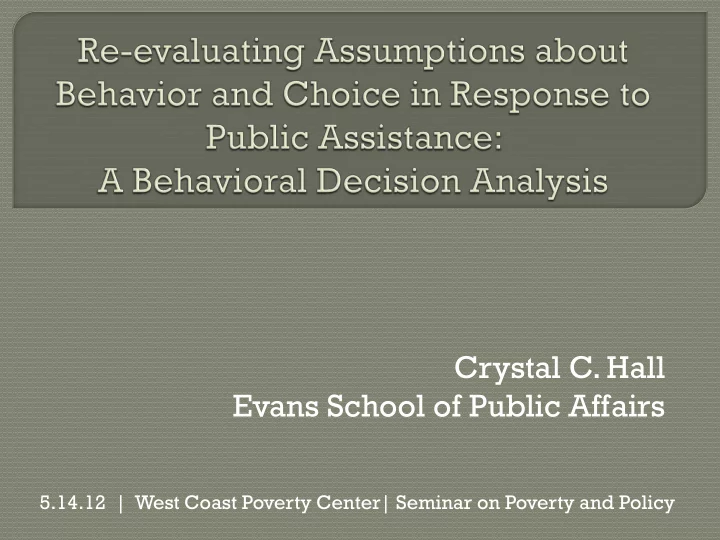

Crystal C. Hall Evans School of Public Affairs 5.14.12 | West Coast Poverty Center| Seminar on Poverty and Policy
Martha Galvez Rachel Kleit Jennifer Romich Mindy Hernandez Jiaying Zhao Devan Berkley Eldar Shafir Jacqui Stork Angela Malorni West Coast Poverty Center • Emerging Scholar Grant
What is behavioral decision research? Examples • Asset building • Housing Choice Voucher (HCV) program • Other social policy research General principles
Typical assumptions of traditional economics not accurate • Rational • Self-interested • Consistent Difference between “normative” and “descriptive” theories of behavior
Rational agent model (normative) • Well-informed • Stable preferences • Controlled and calculating Behavioral model (descriptive) • Mediocre judgment • Malleable preferences • Impulsive *but, behavior is often predictable!!
A key observation: Individuals are “irrational” but often extremely predictable !
Two views of behavior of the poor • Rational agent view • ‘Culture of poverty’ view Behavioral perspective (as an alternative) • Better predictor of behavior (Bertrand, Mullainathan & Shafir, 2006) • Policy implications (Hall, 2012)
Fully understand the context and process Program goals (behaviors!) Mapping the process Design intervention/evaluation
Mindy Hernandez paper
Understanding assumptions about behavior and preferences
Rational agent model (normative) • Well-informed • Stable preferences • Controlled and calculating Behavioral model (descriptive) • Mediocre judgment • Malleable preferences • Impulsive
Why is there often low take-up of public assistance programs?
Assets and Financial Decision Making Housing Choice Other Examples
Self affirmation (Hall, Zhao & Shafir, under review) Mental accounting (Hall & Shafir, under review) Anticipating tax refunds (Romich, Miesel, Keenan & Hall, in press)
Taking Information about EITC Taking Information 0.9 0.8 0.7 Percent Taking 0.6 0.5 0.4 0.3 0.2 0.1 0 Affirmation Neutral χ 2 (1, N=25 ) = 4.57, p= .03
Self affirmation (Hall, Zhao & Shafir et al., under review) Mental accounting (Hall & Shafir, under review) Anticipating tax refunds (Romich, Miesel, Keenan & Hall, in press)
80 70 60 50 HI 40 LI 30 20 10 0 Save $5 on $10 Save $5 on $60
Self affirmation (Hall, Zhao & Shafir et al., under review) Mental accounting (Hall & Shafir, under review) Anticipating tax refunds (Romich, Miesel, Keenan & Hall, in press; Hall & Romich, in prep)
Interviewees predicted refunds averaging $2844 Tax returns showed average anticipated refund of $3906 78% of interviewees under-estimated their refunds, 44% were under by at least $1000
(Hernandez, 2010)
Psychological threat a real issue Individuals not necessarily “bad” at making short term decisions • Incorrect assumptions produce the wrong flavor of intervention, in these cases! • Not about wrong goals or intentions *so must identify other barriers!
Rent subsidies should allow access to “good” neighborhoods but don’t Assumptions: • Preference are for “good” neighborhoods • Low-income people are dissatisfied with their neighborhoods • Resource constraints undermine preferences
Research suggests different perceptions of neighborhoods and opportunity • Positive view of “low opportunity” areas (Galvez, 2011) • Low expectations for schools & neighborhoods (DeLuca & Rosenblatt, 2010) • “Mobility” not a priority (Galvez, Hall & Kleit, in preparation)
Half want to stay in familiar neighborhoods Not always seeking out “better” neighborhoods Small obstacles in the way – move costs • Not a mobility issue, a financial stability issue
Implications for program design • Focus on individual barriers over assumed preferences for neighborhood/school characteristics • Different form of communication • Different interactions with service providers
Impact of Food Subsidies Marriage Preferences Childcare Decision Making
Targeted subsidy on fresh produce (Herman et al., 2008) Comparison of food vs. non-food subsidy Greater consumption after subsidy ends
Impact of Food Subsidies Marriage Preferences Childcare Decision Making
Exploring effectiveness of interventions (Trail & Karney, 2012) • Skills and values based • Less traditional values? Economic realities more of an issue • More traditional values than HI peers • Similar romantic standards • Similar skills-based problems
Impact of Food Subsidies Marriage Preferences Childcare Decision Making
Conceptual frameworks (Chaudry, Henly, Meyers, 2010) Consumer choice (rational) => outcomes Heuristics and biases/social network => processes Accommodation model combines these (Meyers & Jordan 2006) Research that goes beyond a rational choice framework better incorporates social context • Different models for different research questions or methodological approaches • Multiple lenses can improve overall research on decision making
Lessons learned
Understanding behavioral puzzles • Low take up rates of programs and services • Low take up rate of formal banking and savings vehicles Better description of the context Improved policy design and intervention Reduction of financial and social costs
Aiming for “wrong” preferences • Providing wrong incentives • Need more understanding of social context and decision processes (not just outcomes)
Program design misguided, wrong goals • Administrative costs • Program costs Poor perceptions by clients • General frustration • Lack of trust Longer term impacts down the road…
Inaction may not be due to disinterest • Not true of other groups either! • Simple “nudges” often very effective (defaults matter) Start with assumptions *Not always trying to change preferences!
Incentive program for voucher recipients • Financial match for savings pre-move • Similar to IDA programs Assumption: individuals value this large windfall, motivated to relinquish voucher Real preference(?): view losing voucher as a substantial loss, motivated to keep safety net
Loss aversion as a driver of behavior? (Kahneman & Tversky, 1979) Experiments to test could explore: • Savings intention w/ different messaging • Reframing of this benefit Cost of incorrect assumption • Poor marketing • Inappropriate counseling/support mechanisms • More financial instability?
Understanding behavioral puzzles Designing policies and interventions Communicating in an effective manner • Education/advocacy for poor • Education of policy makers
Thank you! hallcc@uw.edu
Recommend
More recommend